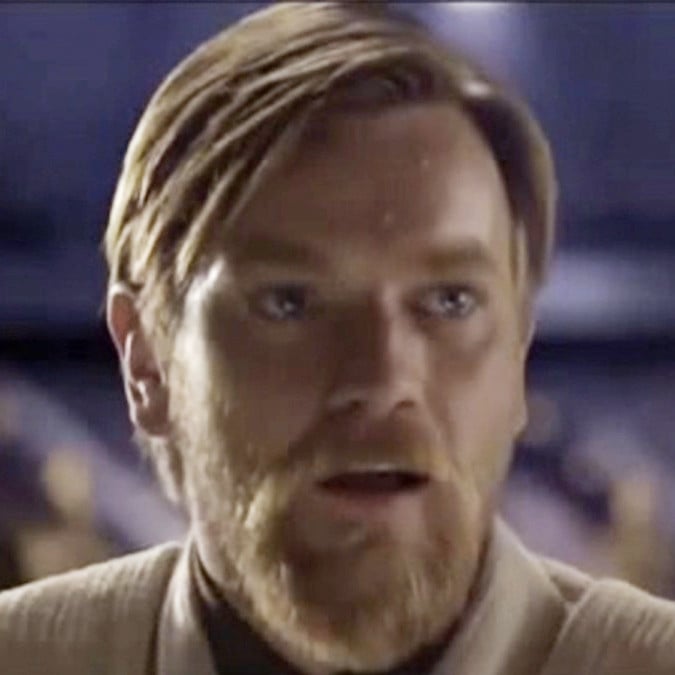

Not that I know of, but damn if I don’t want that to be a thing now.


Not that I know of, but damn if I don’t want that to be a thing now.


One in-universe argument would be that you generally have more precision and striking force with two hands, as opposed to one-handing. This somewhat mirrors some of the “Longswords” that were designed to allow two-handed use, but could also be used with one. Using two weapons at once effectively isn’t quite as easy in real life as it’s made out to be in games and movies (not impossible, just harder to coordinate) but Jedi could obviously circumvent that issue by being space wizards.
Using a Blaster in the second hand would therefore sacrifice melee capabilities, where it seems their command of the force gives them a significant edge over most opponents.
Of course, the ranged capabilities might offset that, but I assume that, up to the Clone Wars, Jedi didn’t often deal with a large number of ranged combatants. Where their reputation wasn’t enough to deterr attacks, their premonition and weapon capable of deflecting shots will have dealt with most attackers, and if they’re ambushed in close quarters the sword would be more useful too.
My reasoning here is that both protections and weapons usually evolve in response to evolutions in the other. If Jedi often enough faced fire so heavy that deflection alone wasn’t enough and some kind of armor would have increased their chances of survival, I would assume they’d wear some (as you see it in the Clone Wars cartoons and the Old Republic games). Equally, if situations where a ranged weapon would have been desirable were a common occurrence, I would assume that the Jedi would eventually have adopted them.
Some degree of reluctance may be explained by religious adherence to their sacred weapon, such that they stuck with it even when the situations they faced evolved during the Clone Wars. Additionally, adopting new doctrines can take time even among less dogmatically rigid organisations.
As someone else replied, a survivor of the Jedi Purge did end up incorporating the Blaster into his arsenal. Without the Order’s dogmatic constraints or a lifetime’s worth of “This is what I’ve always been using”, the barriers of acceptance are much lower. Compounding this, the new threat environment features professional, highly trained soldiers that – memes notwithstanding – are genuinely dangerous marksmen. Under the circumstances, expanding your arsenal beyond the traditional is the pragmatic choice of “uncivilised” survival over dogmatically pure death.
Or just stop your enemy’s heart with your mind.
I have no source for this, but I believe there are some who can do that. It’s just that focusing your force to reach deep into a living creature’s body isn’t quite so trivial to do in the middle of combat.
Or use your super-fast running abilities to jab a fork in your enemy’s eye or something.
At that point, what’s the advantage of the fork over the lightsaber? But I’d assume improvised weapons are a part of their arsenal too, it’s just not as flashy as the bright lightsabers.
Also, to make sure there are no linguistic roots left over on your system that it might grow from again, add --no-preserve-root.


Ain’t that how it usually goes with history? We climb on a hill of understanding to look at the mountains of the unknown beyond.


I now had the time to read it again and think about your comment more thoroughly.
The problem the stormtroopers ran into was that they would succeed at punching through lines, but they still couldn’t solve the issue that the defender had railways and prepared trenches to quickly deploy reinforcements and deliver ammunition, while the attacker’s logistics would be hampered by having to traverse the broken ground. They could secure ground, but not hold it, because the technology to back them up effectively wasn’t there yet.
Essentially, the meme’s approach would see the knights move in under the other guy’s covering fire, butcher the defenders, then get shot by enemies arriving by car while their buddy is still running down the hallway on foot to provide more cover.


You mean on part of Germany? I believe the French and British were inflicting greater rates of attrition on the German front, so just in terms of manpower, they would have eventually overwhelmed the Germans… but the price in lives would have been so horrendous it was always going to come down whose political base collapses first.
Then again, it has been a while since I read the series, and I’m by no means an expert. Maybe the benefit of hindsight and modern analysis would show ways out of that dilemma that wouldn’t have been visible to the commanders at the time – the fog of war was very thick, as far as I can tell.


As ever so often, if anyone is interested in the gruesome reality behind the funny meme, theres An ACOUP series on just how that situation came to be so inescapable and how WW1 technology wasn’t really in a place to break out of the hell of its own making yet.
Weapons had gotten really good at statically hitting targets, but weren’t mobile enough to further support an advance. All you could do was break the first line with it, but by the time you got to the second line the defenders had rallied and pushed you back. The blasted mud and craters between the frontlines hindered moving up your artillery, tanks were in development, but too slow yet, planes were unfit for anything but spotting and the war effort ate most of the resources so there was little left for the development of new technologies. The only option left was to hope that one of your charges would manage to rupture the enemy line and open up space to bring in more troops and start disrupting supply lines. That lucky break always seemed just one more hard push away…


Allegedly they used to, but Musk felt that vision should be enough because humans don’t have radar either and they’re just fine.
https://www.drive.com.au/news/elon-musk-overruled-tesla-engineers-radars-cameras/
The only one that I’m aware of that uses them exclusively one-handed is Dooku, and he’s a bit of a special case. Otherwise, the cases I’m aware of switch between one- and two-handed strikes, which means they’d want their offhand free.
Hence my point: Space Wizards can do that, but that still means there’s no offhand free for a blaster.
Samurai did use bows and other weapons beside their sword, so it’s not that they strictly adhere to one weapon like the Jedi seem to, but yes, Obi-Wan does describe it as “uncivilised”, so that is an element as well.
Since you brought up the analogy, I’ll point out that the Samurai diminished in power and importance as firearms spread, coming to a head with the Satsuma Rebellion that ended with their whole class being disbanded. To a degree, the Jedi being shot down by the newly formed professional army at the behest of the Emperor very much mirrors… well, the Japanese Imperial Army shooting down the Samurai that opposed the reforms (except the Jedi weren’t even given the chance to oppose and rebel, which probably would have gone quite differently).